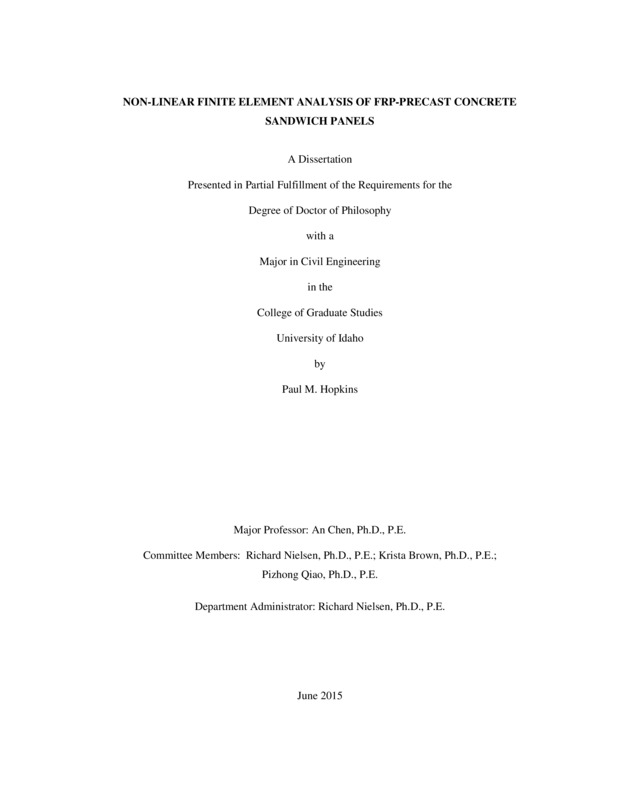Non-Linear Finite Element Analysis of FRP-Precast Concrete Sandwich Panels
Hopkins, Paul Michael. (2015). Non-Linear Finite Element Analysis of FRP-Precast Concrete Sandwich Panels. Theses and Dissertations Collection, University of Idaho Library Digital Collections. https://www.lib.uidaho.edu/digital/etd/items/hopkins_idaho_0089e_10618.html
- Title:
- Non-Linear Finite Element Analysis of FRP-Precast Concrete Sandwich Panels
- Author:
- Hopkins, Paul Michael
- Date:
- 2015
- Keywords:
- Concrete FRP Nonlinear Finite Element Analysis Precast Sandwich Panel
- Program:
- Civil Engineering
- Subject Category:
- Civil engineering
- Abstract:
-
Precast insulated concrete sandwich panels have been used with proven success in commercial building application as wall elements to provide both vertical and lateral strength and thermal and environmental protection. Various configurations and materials have been used to provide certain degrees of strength, thermal resistance and composite action. The mechanics of the sandwich panel rely on the transfer of compressive and tensile forces due to flexure via shear through the web connectors. These web connectors have varied from steel wire trusses to carbon fiber composite grid trusses to solid concrete zones. For optimum thermal performance the connectors not providing a thermal bridge are best suited. For optimum strength and stiffness performance the shear connectors that create the highest degree of composite action and anchorage in the concrete zones shall be used. Furthermore, if the insulated concrete sandwich panels can be better understood, developed and tested in the horizontal application rather than as a wall element, they can be used for roof and possibly floor applications. This will provide environment and thermal resistance and required strength and stiffness.
This study investigates the design and testing of several scaled test sandwich panel configurations using solid web FRP plate shear connectors. The stiffness, strength and degree of composite action for each set of panels is calculated and compared and finally 2 full scale test panels are developed and tested. Along with testing and calculations, numerical modeling or finite element analysis is employed to show correlation between the test results for future development of an analytical model. Precast concrete sandwich panel engineering performance varying depending on the degree of composite action of its constituent materials and strength of properties. Employing a nonlinear numerical solver that can capture the quasi-static response of the panels under flexural loading is valuable and desirable for future development.
These test panels, both scaled and full-scale show adequate results for strength, stiffness and degree of composite action to justify further development and research into their use as roof or floor structural support members. Long term creep effects have also been investigated in this study, however further creep studies are warranted and recommended. Finally, these panels are not limited to the use of residential and commercial application, rather they have the potential as suitable candidates for structures intended to provide blast and/or accidental explosion protection.
- Description:
- doctoral, Ph.D., Civil Engineering -- University of Idaho - College of Graduate Studies, 2015
- Major Professor:
- Chen, An; Nielsen, Richard J
- Committee:
- Brown, Krista M; Qiao, Pizhong; Nielsen, Richard J
- Defense Date:
- 2015
- Identifier:
- Hopkins_idaho_0089E_10618
- Type:
- Text
- Format Original:
- Format:
- application/pdf
- Rights:
- In Copyright - Educational Use Permitted. For more information, please contact University of Idaho Library Special Collections and Archives Department at libspec@uidaho.edu.
- Standardized Rights:
- http://rightsstatements.org/vocab/InC-EDU/1.0/

